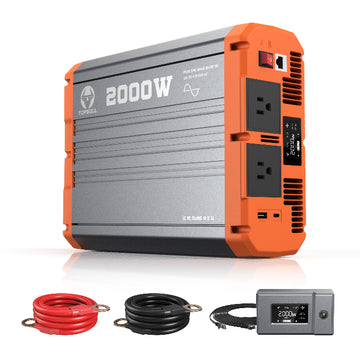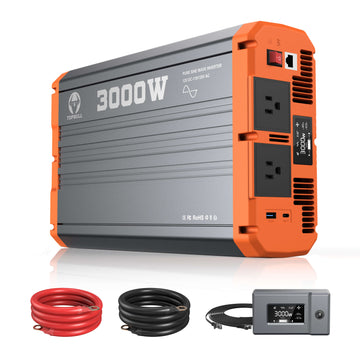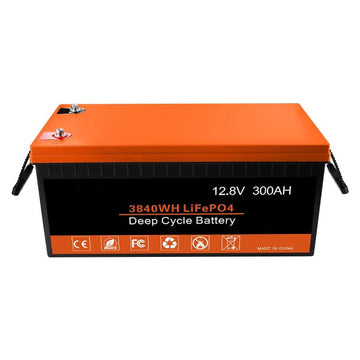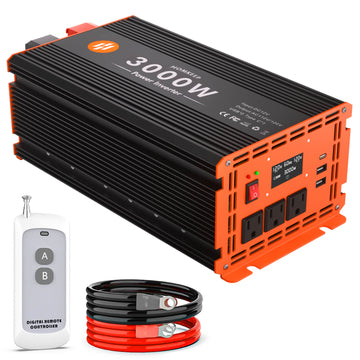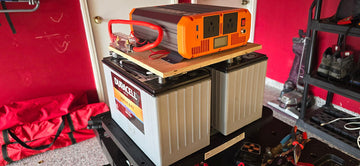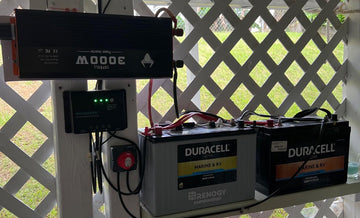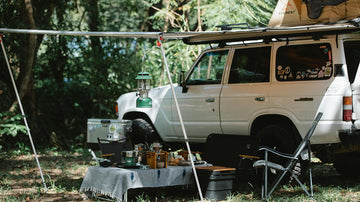The solar inverter plays a vital role in an RV solar system. It converts the direct current (DC) stored in the batteries into alternating current (AC) that can be used directly by homes and appliances. Choosing a suitable solar inverter not only enhances the efficiency of power utilization, but also ensures the safe operation of the equipment and improves the overall experience.
What is a solar inverter and how does it function
A solar inverter is a type of power electronic device that converts DC power stored in solar panels or batteries into standard AC power. For RVs, the solar inverter is the bridge between the solar panels and the electrical devices inside the RV. It ensures that all household appliances, such as fridges, chargers, and light fixtures, are consistently powered.
It's worth noting that an inverter has a different function than a charge controller. The charge controller is mainly responsible for controlling the battery charging process and preventing overcharging and overdischarging, while the inverter is responsible for converting the existing DC power into AC power.

Which type of inverter is best for RVs?
According to the characteristics of RV power demand, Pure Sine Wave Inverter is the most suitable choice for most RV scenarios, while Hybrid Inverter is suitable for users who pursue flexibility and expandability of energy system.
1. Pure Sine Wave Inverter: The first choice
Scenario: All motorhomes with sensitive electronic equipment (e.g. air conditioners, fridges, coffee makers, medical equipment) or those seeking high power quality.
Core Advantages:
-
Equipment compatibility: output waveforms are identical to the mains, no harmonic interference, protects precision appliances (e.g. inverter air conditioners, microwave ovens).
-
High energy efficiency: Usual efficiency ≥ 90%, reducing energy waste, suitable for off-grid system.
-
Low noise: no motor humming during operation, enhancing living comfort.
Limitations: Higher price than Modified Sine Wave Inverter, but lower long term cost (less equipment loss).
2. Hybrid inverter: advanced choice
Scenarios: Users who need multi-energy management (solar + shore power + generator), Li-ion battery compatibility or system scalability.
Core Benefits:
-
Functional Integration: Built-in MPPT controller, battery charger and inverter simplify installation.
-
Flexible power supply: Automatic switching of energy input (e.g. prioritize solar, switch shore power when insufficient).
-
Li-ion Battery Optimization: Supports efficient charging and discharging algorithms to extend battery life.
Limitations: Higher price and some models are heavier and require fixed installation.
3. Modified Sine Wave Inverter: Compromise when budget is limited
Scenario: Short-term travelers who drive only non-sensitive devices (e.g. lighting, cell phone charging) and are on a tight budget.
Core benefits: inexpensive and suitable for basic power needs.
Risks: Possible damage to transformer-type devices (e.g. old TVs, some chargers), noticeable noise during operation.
How to choose?
Prioritize Pure Sine Wave: If the RV has sensitive appliances such as air conditioners, fridges, and medical equipment, or if you plan to use it for a long period of time, a pure sine wave inverter is the most cost-effective choice.
Consider hybrid inverters: If you need to build a complex energy system (e.g., connecting to solar, shore power, and generators at the same time), or if you plan to upgrade your lithium batteries in the future, hybrid inverters offer a more flexible solution.
Avoid Modified Sine Wave: Unless explicitly used only for non-sensitive equipment and with an extremely limited budget, choosing a Modified Sine Wave inverter is not recommended to avoid the risk of equipment damage.
How to match your RV needs?
1. Power Capacity
When selecting an inverter, you need to choose the right wattage capacity based on the total power of the electrical load in the RV. Too large is a waste of cost, too small will not meet the demand. Often the power of the inverter is 1.5 times of the total power of the RV electrical load, for example, if the total power of the RV electrical appliances is 1500W, it is recommended to choose more than 2000W inverter.
2.Voltage Matching
RV common voltage system has 12V, 24V and even 48V, when choosing an inverter, you must match the voltage of the battery system to avoid damaging the equipment.
3. Efficiency and Energy Conversion Rate
Prefer inverters with efficiency ≥90% (quality models up to 95%-98%) to reduce energy loss. High efficiency means less battery consumption and longer battery life, especially for off-grid use.
4. Protections
must have overvoltage/undervoltage, short-circuit, overheating, and reverse connection protections. Advanced features such as low battery cut-off (to prevent over-discharge) and overload current limiting (to protect the infrastructure) enhance system safety and battery health.
5. Installation and Portability
Due to the limited space of RV, the inverter should be reasonable in size and easy to install. For fixed installation, choose the wall-mounted type (space-saving), and for portable needs, choose the portable type. Pay attention to the heat dissipation design, avoid installation in confined space, and leave enough ventilation gap to ensure stable operation.
6. Battery compatibility
Confirm that the inverter supports battery type (lead-acid/AGM/LiPo). Choose the inverter with wider compatibility, such as Topbull pure sine wave inverter compatible with all 12V battery types.
The Best RV Solar Inverter Recommendation in 2025
If the RV inverter market in 2025 is compared to a “battle of energy efficiency and intelligence”, Topbull inverters are standing out from many other brands due to their technological innovations, scenario suitability and cost-effectiveness. Here are the reasons for the recommendation and core advantages:
1. Full coverage of power bands, accurate matching of needs
Topbull offers a full range of power bands from 2000W to 4000W, covering the scenarios from small campervans to luxury motorhomes.
- Lightweight travel: 2000W model supports basic equipment (lighting, laptop, small fridge), small size and extremely portable.
- Long-term off-grid: 4000W inverter can drive air conditioner, induction cooker, built-in intelligent overload current limiting, short overload without power supply, to protect the core equipment operation.
2. Conversion rate breaks through the industry bottleneck
98.5% peak efficiency, saving 15%-20% energy compared to traditional inverters, extending battery life by more than 30%.
3. 7 built-in protection mechanisms
Topbull inverters are equipped with 7 built-in protection mechanisms, including overload, over-voltage, under-voltage, high temperature, short-circuit, leakage and reverse connection protection. Automatic shutdown when the battery power is ≤15%, avoiding the risk of lithium battery lithium precipitation.
4. Li-ion compatibility benchmark
The whole series supports 12V LiFePO4/ Li-ion ternary/ lead-acid batteries to meet diversified power needs
5. Intelligent temperature-control technology
The Topbull inverter is equipped with dual intelligent temperature-control fans, which effectively reduces the temperature of the equipment, reduces battery consumption and prolongs the life of the batteries
6. Cost-effective subversion of the tradition
The price of the same power section is 30-40% lower than that of Victron, and its performance has reached its 90% level, which is suitable for the budget. The price is 30%-40% lower than Victron in the same power range, but the performance is 90% of its level, which is suitable for users who are sensitive to budget but in pursuit of high quality.
Recommended Models and Scenarios

Topbull 2000W Pure Sine Wave Inverter: Designed for lightweight travelers, the lightweight body with 95% high efficiency conversion can easily drive fridge, lighting and other basic equipment. It supports all 12V batteries and 300W-500W solar panels, and the intelligent low power protection extends the life of lithium-ion batteries, making it the cost-effective first choice for short-distance camping, boating, or emergency power backup.
Topbull 3000W Pure Sine Wave Inverter: The power hub of family RV, can power air conditioner and induction cooker at the same time, suitable for 4-6 people traveling off-grid for a long period of time, to meet the demand of multi-equipment power, taking into account the stability and practicality.
Topbull 4000W Pure Sine Wave Inverter: Industrial-grade solution for luxury RVs and professional scenarios, easy to drive high-power inductive loads such as welding machines and hydraulic equipment. Military-grade components, ruggedized and durable, suitable for extreme adventures or commercial mobile showrooms with high expansion needs.
How to install and maintain RV solar inverter
Installation location: well ventilated, away from heat sources, avoid humid environment, reserve space for maintenance.
Wiring specifications: use the appropriate wire diameter (e.g. 4000W system requires 8AWG wire), positive and negative terminals to prevent accidental contact, connect the power cord correctly, and make sure it is well grounded
Maintenance As for maintenance, RV inverter maintenance is relatively simple, but you need to check whether the lines and interfaces are firm on a regular basis, clean up the inverter vents of dust, monitor its operating temperature, and troubleshoot abnormal sounds or alarms in a timely manner.

Tips for improving your RV power experience with a solar inverter
Match high-capacity, high-quality batteries
Choose storage batteries with sufficient capacity and stable performance to ensure reliable power supply even on cloudy days and at night.
Manage loads wisely
Avoid turning on multiple high-power appliances at the same time to reduce current spikes and extend battery life.
Optimize solar panel angle and cleanliness
Adjust the angle of the panels according to the light, and clean dust and debris regularly to improve charging efficiency.
Regularly monitor the system status
Pay attention to the power and equipment operation status, adjust the power consumption strategy in time to prevent over-discharge and equipment damage.
Conclusion
Choosing the right solar inverter is the key to creating an efficient and reliable RV solar system. By reasonably matching the power capacity and focusing on the inverter type and protection features, it can make the RV electricity safer and more stable. For users who pursue high quality and good performance, Topbull inverters have become the preferred brand for many RV users with their pure sine wave output, high efficiency conversion rate and rugged design. Whether for daily life or long-distance traveling, Topbull inverters can protect your RV power system and enhance the comfort and convenience of outdoor life.

